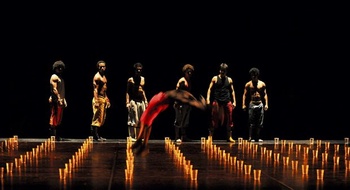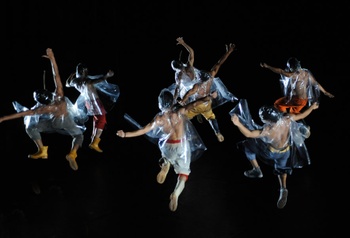(Agwa © Michel Cavalca)
In a double-bill evening of hybrid hip hop, the French choreographer Mourad Merzouki (Cie Käfig) propels eleven Brazilian dancers into Correria, which is followed by Agwa, a choreography with…300 plastic cups!
Having served his time in circus and hip hop, the French choreographer Mourad Merzouki has a definite fondness for mixing a wide range of genres, from his hip-hop roots to contemporary dance and Asian dance – he has even come up with a choreography drawing on the world of boxing with the Debussy Quartet performing live! His recent works have created a number of strange worlds and he even has a project in mind for an improbable choreography that would bring together circus folk and…sumo! In the meantime, here he is with eleven Brazilian dancers for an evening made up of Correria and Agwa, a “hit” first performed in 2008. There will be two performances in Brussels, at Wolubilis.
Are you “hip-hop fusion”?
Mourad Merzouki: I like taking hip hop somewhere else, making it take risks, confronting it with other worlds (Asian, Brazilian, etc.), so as to get away from being stuck in a demonstrative kind of dance, the “battle”, or street dancing. I like, moreover, encountering dancers from other countries. While the fundamentals of hip hop are the same everywhere, it is also shaped by the cultures of different countries. Asian or Indian hip hop, influenced by their traditional dance and music, is different from French hip hop.
What is the approach in Correria and Agwa?
Merzouki: I met Brazilian dancers from the favelas of Rio de Janeiro. We worked on their dancing: hip hop, capoeira, and samba as well as, for example, a rather unusual scene for them in which they only dance with their fingers, without the captivation of technique, the muscles, and the stunts. Then, as I didn’t want to create a choreography that would be a “postcard from Brazil”, I suggested dancing on two universal themes: running (Correria) and water (Agwa). The frenetic running around of our time and water as something precious and threatened.
In a choreography threatened by 300 plastic cups?
Merzouki: I love working on my sets. We didn’t have great resources available, so the cups, which didn’t cost much, made possible an appropriate set that referred to an unexpected dimension, pushing the dancers to work in a particular way – the challenge being to work on the non-destabilisation of the dancers, alone or in a group amid the cups.
Cie Käfig keeps the water running


(Correria © Michel Cavalca)
And in Correria?
Merzouki: A different world. With a screen set, while the choreography about running is (and accelerates in a way that is) “rawer”, whereas Agwa is lighter and more poetic, building towards a crescendo of tension.
Does music play a role?
Merzouki: I (always) use a patchwork of world music; in this case, music from Eastern countries, Brazil, etc. – not much hip hop, in the end. The music allows the dancers to be generous onstage, more communicative than in an intellectual contemporary dance piece, because they have kept a rough dancing style that the audience likes.
With no female dancers…
Merzouki: That wasn’t a deliberate choice. I auditioned a hundred dancers from Rio with hip-hop roots. I didn’t see a single girl there! It must be said that in our professional sector, when you audition for a contemporary choreography, more girls turn up than boys; in a hip-hop audition, it’s the other way round. In my other choreographies, there are female hip-hop dancers, but not here. There are just the eleven male dancers.
CIE KÄFIG: CORRERIA & AGWA • 23 & 24/1, 20.30, €16/21/23/25, Wolubilis, avenue Paul Hymanslaan 251, Sint-Lambrechts-Woluwe/Woluwe-Saint-Lambert, 02-761.60.30, www.wolubilis.be
And in Correria?
Merzouki: A different world. With a screen set, while the choreography about running is (and accelerates in a way that is) “rawer”, whereas Agwa is lighter and more poetic, building towards a crescendo of tension.
Does music play a role?
Merzouki: I (always) use a patchwork of world music; in this case, music from Eastern countries, Brazil, etc. – not much hip hop, in the end. The music allows the dancers to be generous onstage, more communicative than in an intellectual contemporary dance piece, because they have kept a rough dancing style that the audience likes.
With no female dancers…
Merzouki: That wasn’t a deliberate choice. I auditioned a hundred dancers from Rio with hip-hop roots. I didn’t see a single girl there! It must be said that in our professional sector, when you audition for a contemporary choreography, more girls turn up than boys; in a hip-hop audition, it’s the other way round. In my other choreographies, there are female hip-hop dancers, but not here. There are just the eleven male dancers.
CIE KÄFIG: CORRERIA & AGWA • 23 & 24/1, 20.30, €16/21/23/25, Wolubilis, avenue Paul Hymanslaan 251, Sint-Lambrechts-Woluwe/Woluwe-Saint-Lambert, 02-761.60.30, www.wolubilis.be
Read more about: Podium
Fijn dat je wil reageren. Wie reageert, gaat akkoord met onze huisregels. Hoe reageren via Disqus? Een woordje uitleg.